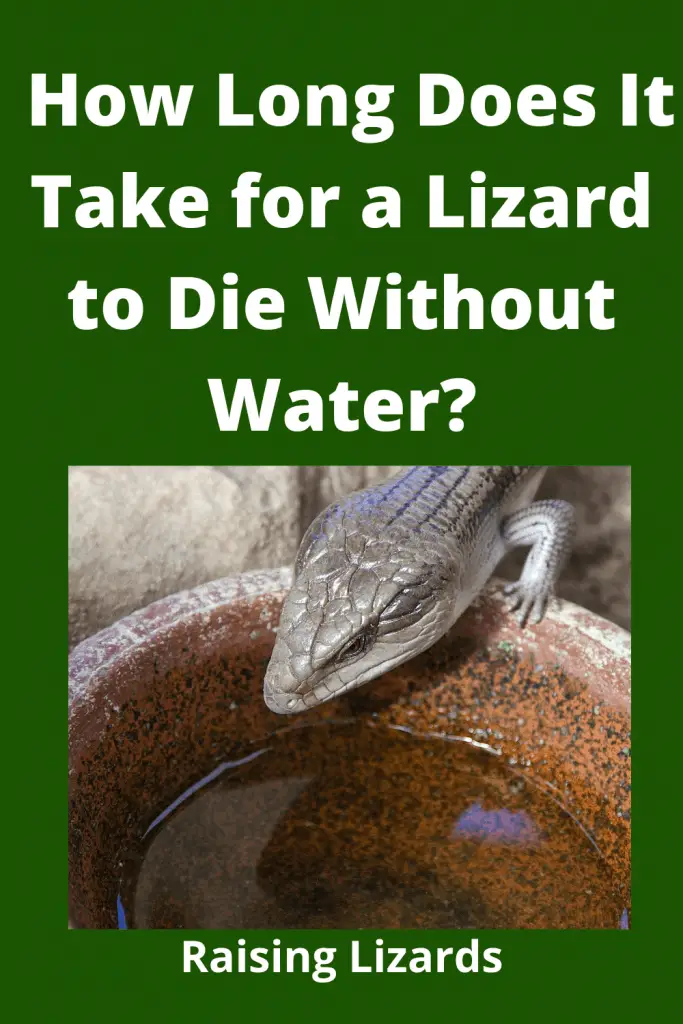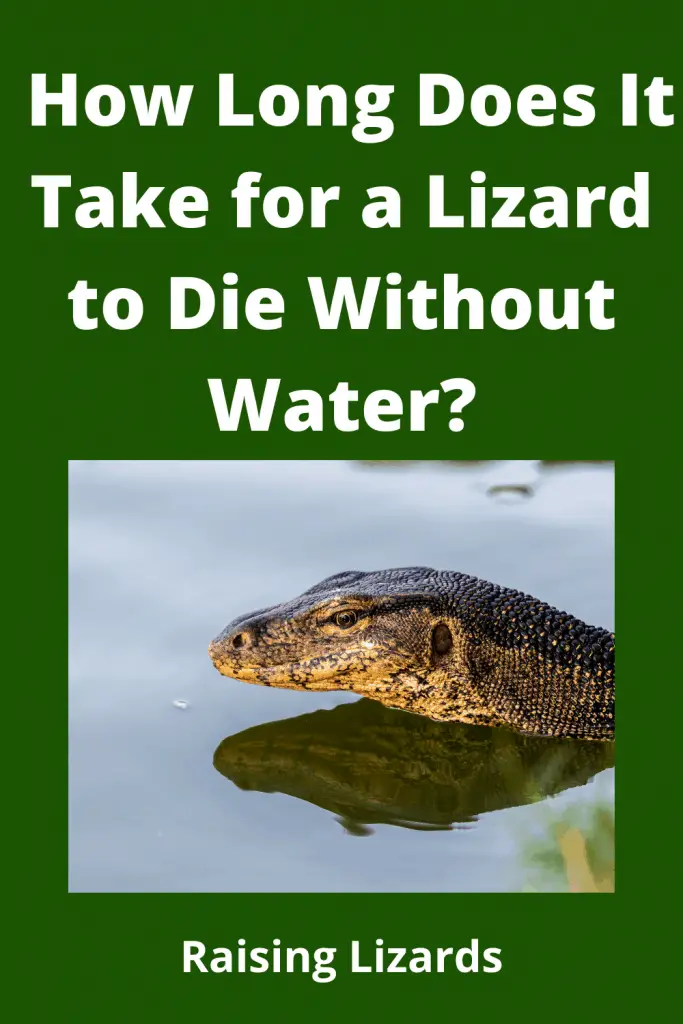How Long Does It Take for a Lizard to Die Without Water? Lizards can go without water for a surprising amount of time due to its dry and hot nature. Depending on the reason for their lack of water, they can still survive without water from 3 days to 2 weeks, but this should not be stretched, and other considerations should be checked as you go.
Water is less of a problem to lizards than is temperature regulation. All reptiles excrete uric acid and thus do not need great amounts of liquid to rid themselves of nitrogenous wastes. All insectivorous lizards take in a large amount of water in the prey that they consume, and herbivorous lizards have salt glands for the active excretion of mineral salts. Because of their low metabolic rates relative to those of birds and mammals, lizards use less water.
This may account for their success at colonizing oceanic islands and surviving in extreme deserts. Some lizards in extreme environments harvest water from the dew that collects on their skin in the early morning, and thus deserts do not pose severe problems to them. In addition, lizards form a conspicuous portion of the fauna of oceanic islands, where the species diversity of amphibians and mammals is generally low.
Even while riding on mats of floating vegetation in rivers and oceans, many lizards can survive for long periods without fresh water. This quality makes them ideal colonizers, and hard-shelled gecko eggs seem to be particularly equipped for such journeys.

Other variables that affect lizards are day length (photoperiod) and rainfall. Lizards living far from the Equator experience marked variation in photoperiod, with short winter days and long summer days. Certain species are adapted to respond to such cues.
Anolis carolinensis of the southeastern United States ceases reproduction in the late summer and accumulates fat for winter hibernation. This change occurs while the days are still warm and appears to be triggered by decreasing day length.
This environmental trigger is adaptive for the species because eggs laid in September would essentially be wasted, as the young hatched in November would likely starve or freeze to death. Some tropical species respond to alternations between rainy and dry seasons, and egg-laying activities may cease during the driest months of the year when food resources are low. Under these conditions,
it is advantageous for the parent not to channel valuable energy into the production of eggs, and the eggs themselves might be less viable because of the threat of desiccation.

How Long Does It Take for a Lizard to Die Without Water ? Water Benefits for Lizards
It is essential for lizards to find water and conserve it for their daily life to make sure that their body and cellular function works great. Lizards usually originated in dry and hot places or habitats and some lizards have harder scales to prevent fluids from evaporating.
The water is important for the lizard’s kidney since it is concentrated with body waste that can be converted into harmful acids. So water is a need for them to flush these harmful chemicals and toxins from their bodies. Water is also important for
- Getting enough water makes the bodywork properly and more efficiently.
- Water helps boost the immune system and avoid diseases
- It also provides good blood flow and boosts the activeness
- Promotes good digestion and helps flush out harmful toxins from the body.
- Water helps to regulate body temperature.
Different Sources of Waters for your Lizards
Tap water; It is important to check first if your tap water at home is safe for your lizards. There are a lot of things to consider because in some places tap waters can be dirty or polluted, so it is better to research more about the water in your area to make sure it’s safe for drinking.
Tap water is a great way to hydrate your lizards since it comes directly from nature and there are a lot of natural minerals or elements that are good for your lizard. But you also need to make sure there are no harmful chemicals like chlorine.
Well Water, when giving your lizards well water you also need to check if it’s not too salty. Sometimes well water comes partially from the sea and that is why it can be salty. Pumping it out can also be harmful if it got contaminated with other elements like copper, lead, and metal. Make sure the water is safe for your lizard.
Rainwater: Rainwater is more natural compared to other sources of water. You can get a big container so that you can collect water whenever it rains. It is also recommended to use a net or filter to avoid dirt to come into the water.
You can also collect rainwater using tarps or any plastic container to make sure it is safe for your lizards. If you have larger lizards and you are putting them outdoors it is a great idea to create a pond where they can have unlimited access to their water.
Bottled Water: Bottled water is the safest one since it is proven and tested by laboratories. So, if you think that your water sources are too dangerous and not safe for your lizard giving them bottled water is a good idea since there is no chemicals, bacteria, or other contaminants. It might be a little bit costly, but it is safe for your lizard.
Food or plants: Some reptiles get or extract their water from some fruits or plants to survive. This is the safest source of hydration that they can get not only that they can get water from plants, fruits, vegetables, etc. but they can also get nutrients from them. Lizards are born wild and are survivors hunting and finding their own food.
Mist: There is a lot of mist that you can get from vegetables, fruits, etc. This type of water source is great for smaller lizards. It helps them get water and the humidity that they need in a tank. You can also spray them with bottled water, just make sure that is clean. You can also find great mist systems in pets stores that are made and designed for your reptiles.
How to Save a Hungry & Dehydrated Lizard
Severe dehydration can result in weakness, shock, disorientation, muscle twitches, irregular heartbeat, and coma. Inadequate drinking water, low humidity, high temperatures, poor diet, disease, and infection can all contribute to dehydration.
Call your veterinarian first thing if you have a dehydrated lizard. Steps to take in lieu of the vet’s input include feeding the creature electrolyte or soaking him in it. Do not feed the pet until it is well.
- Mix electrolyte beverage with an equal amount of lukewarm sterile water. Fill an eyedropper with the diluted electrolytes.
- Use the eyedropper to place a drop of the diluted electrolyte on top of the lizard’s snout. Watch for him to lick it up. If he does, drip a few drops on his tongue as he is licking. If he does not lick at the drop on his snout, you will have to force him to take the liquid or give him a soak instead.
- Holding the lizard’s head steady and level, open his mouth by gently pulling down on his dewlap. This is the loose flap of skin under his chin.
- Place a few drops of electrolyte solution on the front of his tongue. Gently rub under his throat and on top of his head to help him swallow. Repeat until the creature has ingested the proper amount of fluid.
Soaking
- In a saucepan, mix equal parts pediatric electrolyte beverage and sterile water, making enough for use in the plastic container or dishpan. Gently heat the solution to lukewarm.
- Place the plastic container or dishpan on a folded towel. Fill it with the lukewarm electrolyte solution to a shallow depth that’s comfortable for the lizard.
- Place the lizard in the container and allow him to soak. Remove him from the electrolyte solution before it gets cool. Rinse the solution from the lizard’s body with fresh lukewarm water.
Feeding habits
Most lizards are active during daylight hours when their acute binocular vision can be used to its greatest advantage, and vision is necessary for most nonburrowing species.
The family Gekkonidae, however, is composed predominantly of species that are most active from dusk to dawn. In conjunction with night activity, geckos are highly vocal and communicate by sound, whereas most other lizards are essentially mute.
Lizards spend considerable time obtaining food, usually insects. Iguanian lizards, anoles, agamas, chameleons, and others tend to perch motionless at familiar sites and wait for prey.
They detect their prey using visual cues, dash from their perches to where the prey item is, and capture it with their tongue in a process known as lingual prehension. Iguanian lizards are typically referred to as “sit-and-wait” predators. The true chameleons are the most extreme examples of this mode of foraging; they move slowly, scan the habitat with eyes that move independently of one another, and capture their prey by shooting out a sticky projectile tongue.
(In some cases, their tongues can extend to twice their body length.) Chameleons effectively eliminate the need to pursue their prey, which is the riskiest aspect of the sit-and-wait foraging mode.
In contrast, autarchoglossan lizards (the non-gecko scleroglossan lizards such as amphisbaenians, skinks, whiptails, and others) actively search for prey by probing and digging, using their well-developed chemosensory system in a process called vomerolfaction, as well as visual cues.
These lizards do not use the tongue to capture prey; rather, they grab their prey in their jaws (jaw prehension). As a result, the tongue is free for use as an organ of chemoreception. Geckos also use jaw prehension, but they use olfaction for discriminating between chemical cues rather than vomerolfaction.
Some lizards are herbivorous. The largest of the iguanian lizards, such as the iguanas (Iguana, Ctenosaura, and Cyclura) and the spiny-tailed agamid (Uromastyx), eat plants. However, the large body size is not necessary for herbivory (many small herbivorous species in the genus Liolaemus exist), and the very largest lizards, such as the Komodo dragon (Varanus komodoensis) and other monitor lizards, are carnivorous.

Defensive Strategies
Many birds, mammals, invertebrates, and other reptiles’ prey on lizards. In response, lizards have a variety of defensive strategies to draw upon. For example, chuckwallas (Sauromalus) typically remain close to rock piles. When danger threatens, they move into small crevices and puff up their bodies to make their extrication difficult.
Several spiny-tailed lizards also move into crevices and leave only a sharp, formidable tail exposed. The African armadillo lizard (Cordylus cataphractus) holds its tail in its mouth with its forefeet and presents a totally spiny form to an attacker. Predators, such as snakes, that attempt to swallow an armadillo lizard will often fail because the lizard offers no start point from which swallowing can begin.
The frilled lizard (Chlamydosaurus kingii) of Australia extends a throat frill that frames its neck and head to intimidate intruders on its territory. This frill is almost as wide as the lizard is long. In addition, the tails of many lizards break off (autotomize) easily. This broken-off section wriggles rapidly and often distracts the predator as the tailless lizard scurries for cover. Autotomized tails are often regenerated quickly.

